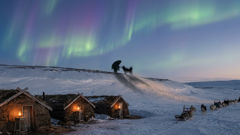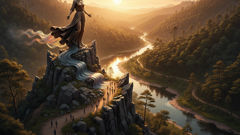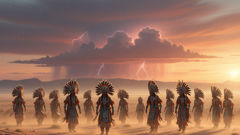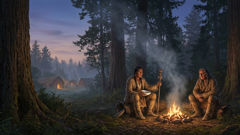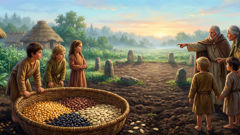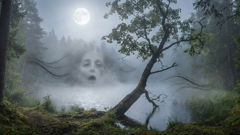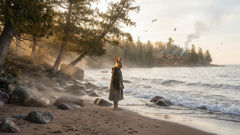Introduction
On the open ice, beneath a sky that sometimes burns green and violet with the aurora, the world narrows to wind and horizon and small, stubborn fires. In the long hush of Arctic nights, stories travel along the same currents that carry breath and scent: folded into sealskin, passed by lamplight, woven into the careful cadence of elders' speech. Among those stories is the Ijiraq, a presence that refuses to be pinned down by a single face. It moves like a thought slipping away, a friend who becomes a stranger, the shape of a fox that unfurls into a child, a glimmering seal that vanishes under the ice. The Ijiraq does not simply frighten; it disorients. Travelers say it rearranges snowdrifts into false paths and steals the names and histories lodged in one's head, leaving a hollow where memory should be. This tale traces the Ijiraq's footprints across sled tracks and shoreline, through whispered warnings and ceremonials, and into the cautious curiosity of the present. It traces how a myth about shape and loss became a cultural compass for navigation, community memory, and respect for a landscape that refuses to be dominated. Listen, then, with the kind of attention the ice demands: not to conquer meaning but to hold it lightly, as one holds a fragile bone that might yet be warm.
Origins, Warnings, and the Shape of Memory
The Ijiraq is older than a single telling; it lives in the rhythms of the Arctic itself — ebb and drift, thaw and freeze. Elders speak of the creature in measured phrases, often as part of larger lessons: how to travel when visibility falls, how to listen for the subtle cadence of wind, and how to carry a community's memory when individual recollection frays. Though versions vary from village to village across the north, the story returns to common threads: the Ijiraq is a shape-shifter, it is drawn to the lonely and unwary, and its influence is not merely physical but cognitive. To encounter an Ijiraq is to be invited into a different logic, where places you thought you knew rearrange themselves, and names you rely on slip like wet stones from your mouth. The creature's origins are not pinned to a single genealogy. Some accounts describe it as a being expelled from companionship, a soul that in life chose severance and in death could not find rest. Others place it among spirits consequential to the land — kin not of human law but of weather and ice. Anthropologists and community historians have recorded storytellers saying that the Ijiraq serves a social function: the possibility of memory loss becomes a reason for collective vigilance. If an individual can forget a path or a kin's name, then the group must cultivate redundancies — shared maps etched into rock and song, repeated names at gatherings, and rituals that reroute the disoriented back into the social weave. The warnings are careful and practical. Never travel alone at dusk when the light falters; mark your line of travel with bright pieces of hide or carved notches so the snow cannot rearrange your path into a lie. Speak aloud the names of those with you and the names of important places; claim memory as an act of companionship. The Ijiraq's method is subtle in most tellings. It rarely attacks in the feral sense; it tempts, or misleads, or waits until a traveler thinks they are following a familiar ridge and finds the world has rearranged itself into an unworkable geometry. In such moments panic is the Ijiraq's ally. A lost man, quick with fear, might forget the face of his wife, the reason for a child's name, even how to return to his sled. When memory slips, a person becomes unanchored from the social network that keeps them alive. Indigenous intellectuals have emphasized that myths like the Ijiraq are not only cautionary but instructive: they encode survival knowledge. The danger of disorientation in a treeless, white landscape is real; the Ijiraq concentrates that danger into a character whose moral is not a simple good-versus-evil dichotomy, but a reminder of mutual dependence and the fragility of knowing. There are ceremonial responses, too. In certain communities a drum song may be sung to call a lost person's memory back into the circle, or elders might lead a retracing ritual where the village collectively repeats the names and events the absent one has forgotten. Such practices are not superstition alone; they are the social technology of memory, a cultural infrastructure deliberately designed to counter the appetite of forgetting. Ethnographers who have worked respectfully with Inuit storytellers note that these rituals reinforce community bonds and share responsibility for individuals' recollection and direction. The Ijiraq thus becomes an agent in conversations about how memory is stored, shared, and recovered. It is tempting to interpret the creature as symbolic — a projection of Alzheimer-like conditions or the psychological weight of isolation — and there is truth in those readings. But to reduce the Ijiraq to an allegory risks stripping the story of its animate, reciprocal character. The Ijiraq is not merely a mirror for human fear; it is part of a living cosmology in which the land, animals, and people speak in reciprocal patterns. To recall a ritual, to name a place aloud, to mark a trail — these are acts of reciprocity that keep the Ijiraq at bay. And so the story works in two registers at once: it protects bodies and teaches community habits, and it situates forgetting within a network of response rather than leaving it as a private doom.
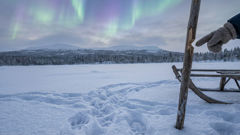
The way the Ijiraq is described physically ranges from the nearly invisible to vividly grotesque. Some older storytellers frame it as an animal-like being, capable of slipping between fox and seal, wind and human; others emphasize an uncanny sameness — faces and shapes that are slightly off, eyes too still, or a mouth that repeats words with the wrong cadence. That wrong cadence matters. Language is a map across which relationships are maintained; a mispronounced name can be a sign of misrecognition and an early symptom of the creature's work. Recounting these variances, storytellers teach listeners to be attentive to the small misalignments that signal danger: a path that slants where it should run straight, a shadow that lags behind its source, a voice that calls with a familiar nickname but from the wrong direction. In some versions, the Ijiraq can be recognized by the way snow falls around it — the flakes spiral in a way that suggests a tunnel, or they filter down in a fine, glassy sheet. In others, the creature leaves no prints, or leaves prints that double back and join themselves, creating loops that sew confusion into the landscape. Such details are useful. A hunter who reads the subtle discrepancy in tracks can decide whether to proceed or to retrace steps with a partner. These observations are recorded not like scientific specimens in jars but like lines in a communal instruction manual, passed from lip to lip.
Beyond practical guidance, the Ijiraq teaches a deeper ethic about remembering others and remaining accountable. Where modern culture values individual autonomy, traditional Arctic life privileges interdependence. The threat of forgetfulness is therefore not only a personal tragedy but a social rupture. The Ijiraq reminds people that memory is collective work: stories must be re-told, histories repeated, names pronounced. When a name is forgotten, the person it belongs to is unmoored; remembering restores that person's place in the social order. Through this lens, Ijiraq stories are at once mythic caution and ethical primer; they bind practical safety rules to the moral demand that we sustain one another's identity in a world that can erase so readily.
Encounters, Modern Reflections, and Cultural Meaning
Over decades, accounts of Ijiraq encounters blend ritualized narrative with the raw edge of lived experience. In one telling, an elder recalls a boy who left camp after a petty quarrel and wandered until the evening collapsed into a white blur. People called his name and found him three days later near a bluff, naked in the wind, unable to recall the names of his parents or even where he had been headed. He remembered only a shapeless warmth and a feeling of being led like a thread through a labyrinth. Another story speaks of a woman on a hunting trip who followed the outline of a seal on the ice, only to find the shape elongating into a child's silhouette that grinned and slipped beneath a snowdrift. She escaped because she had tied a bright fringe of dyed fur to her arm, a marker the Ijiraq could not fully replicate. Such fragments of narrative serve as both testimony and instruction. Modern writers, anthropologists, and community historians have tried to document these accounts, but the best records remain the oral ones, refined by generations. Scholars caution against treating these testimonies as simple folklore: they are expressions of a continuing, living culture in conversation with its past and present. The Ijiraq is also a mirror for the modern world's anxieties. As climate change reconfigures the Arctic, places once reliable for travel shift in new and literal ways; permafrost thaws, shorelines retreat, sea ice forms later and melts sooner. The metaphor of disorientation that the Ijiraq embodies has fresh resonance as traditional knowledge interfaces with unpredictable environmental change. Elders sometimes tell the Ijiraq stories in gatherings now not only to instruct children about sled etiquette but to articulate sorrow and bewilderment about a landscape that no longer keeps its ancient rhythms. In that context, the Ijiraq's power can be read as a symbol of environmental unpredictability, a figure that reasserts itself when the land alters its rules. Yet there's a danger in letting metaphor swallow the creature whole. The Ijiraq, even in stories that clearly comment on shifting ice, persists as an independent actor in narratives: it tempts, it laughs softly, it is indifferent to human moral frames. That independence is significant. It calls listeners to a stance of humility: not only must humans adapt, but they must listen deeply to other agencies in the Arctic and resist simplifying those agencies into human categories of villain or victim. Artists and storytellers of Inuit heritage have responded to the Ijiraq in varied ways. Some paint it as a luminous figure barely caught on canvas, an absence that becomes form. Poets have written of the way a missing name distorts a whole stanza of memory, and filmmakers have used stark, slow frames to suggest the creature's subtle erasures. These contemporary renderings are acts of cultural continuity; they keep the Ijiraq present while allowing the story to evolve. The ethics of retelling are important here. Non-Indigenous audiences must approach the Ijiraq with respect and attention to context. For many Inuit, stories are not commodities; they carry responsibilities. Scholars have criticized the extraction of Indigenous myths for entertainment without reciprocal engagement with communities. Equally important is recognizing the authority of elders and the living holders of tradition. In many communities, certain stories, their cadence, and their ceremonial uses are preserved by named individuals and lineages, and their retelling outside those contexts without permission risks harm. Where retellings are welcomed, they can foster solidarity and shared understanding about the Arctic's social and ecological challenges. In some modern narratives, the Ijiraq becomes a screen upon which questions about identity are projected. As migration, schooling, and global media shape younger generations' lives, the rituals that once bound memory are sometimes weakened. The Ijiraq then emerges in story as a test: will memory be maintained through repeated names and shared songs, or will it erode into a private loss? Community-led programs that revive storytelling, language classes, and intergenerational visits respond directly to this pressure. In that sense, the Ijiraq catalyzes civic action. Where the Ijiraq warns of forgetting names and paths, cultural programs restore the songs and mapping practices that anchor people once again. The figure is also present in legal and political discourse. Indigenous leaders point out that the erasure of history — colonial suppression of language, relocation policies, and residential schooling — creates conditions not unlike those the Ijiraq exploits. The parallel is blunt and productive: forgetting is not only a risk from the wind; it is also a consequence of political violence. Framing some of these historical wounds through the metaphor of a creature that steals memory helps communities to name collective losses and to mobilize efforts of remembrance and restitution. Yet the Ijiraq resists becoming a single didactic emblem for everything that has gone wrong. Its stories retain paradox. In some accounts, after leading a person astray, the Ijiraq offers a test or a gift: a new perspective on place, a recalibration of how one belongs to the land. That ambiguity preserves a crucial lesson: in a world where change is constant, some forms of disorientation can be openings, not only threats. They can force communities to re-tell their stories, to repair frayed relations, and to invent new maps that respect both continuity and adaptation. Tellingly, many elders insist on balance when they speak of the Ijiraq: respect the creature's power, but do not surrender agency to it. Mark your routes, repeat your names, and keep company with those who remember — and in doing so you practice a kind of cultural resistance to both the forgetting of the wind and the forgetting imposed by history.

Conclusion
Stories of the Ijiraq teach us how fragile memory can be, and how strong the remedies of attention and community are when we refuse to let forgetting take root. The creature's shapeshifting is a narrative device that anchors practical survival lessons to an ethic of remembrance: name those you love, mark your path, gather together when confusion spreads. In contemporary life the Ijiraq continues to matter because it speaks to the ways place and history hold people together, and how damage to either can loosen the cords that bind a community. To retell the Ijiraq conscientiously is to listen for the elders' cadence, to respect the protocols that guard stories, and to join in the work of remembering through song, map, and shared names. In doing so we keep alive both warning and care, and we protect not only bodies traveling across ice but the stories that make a human life recognizable to others.

